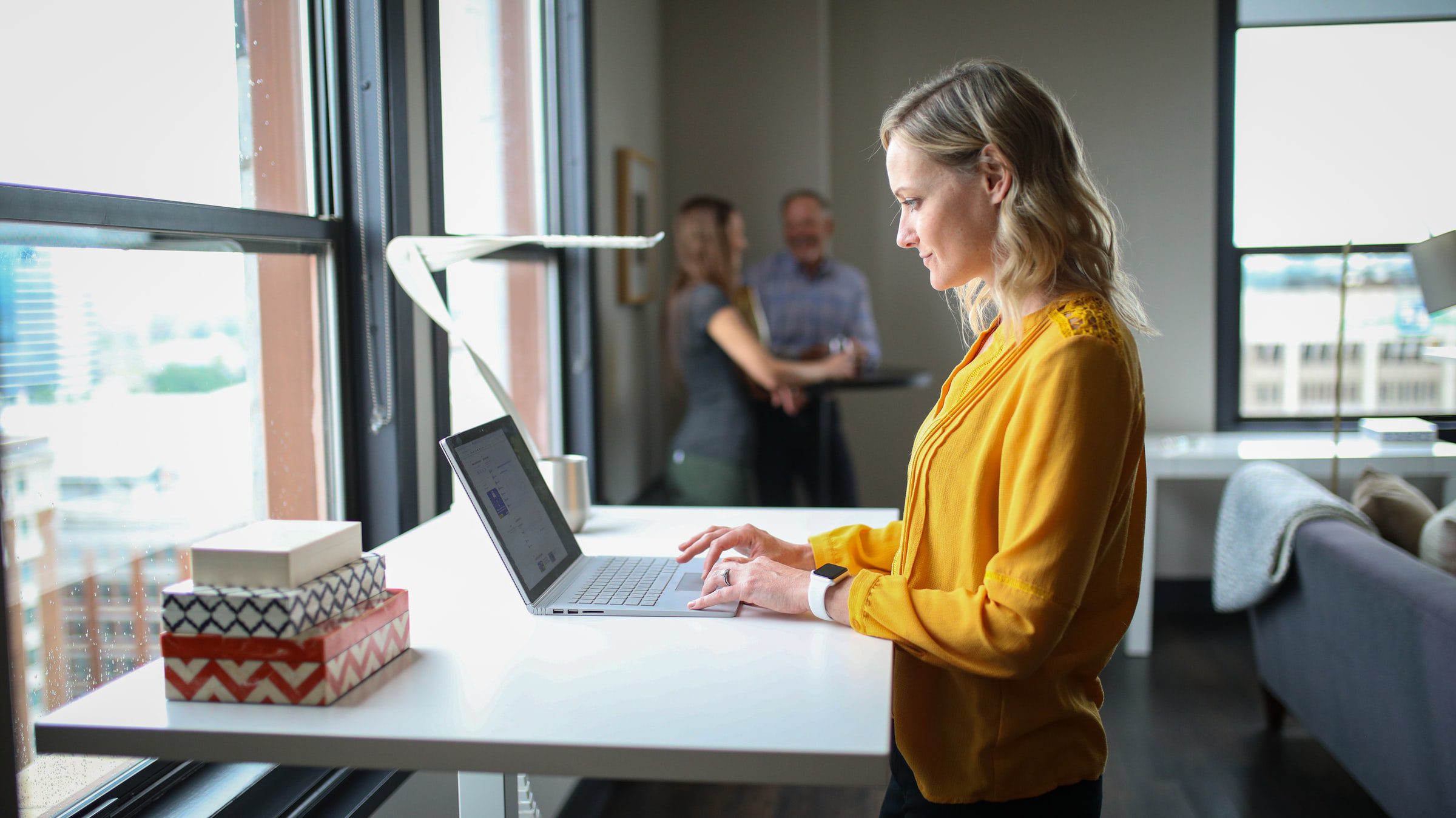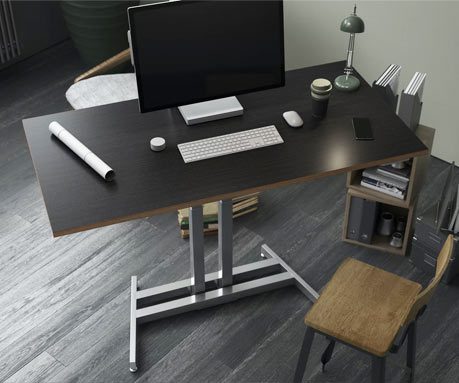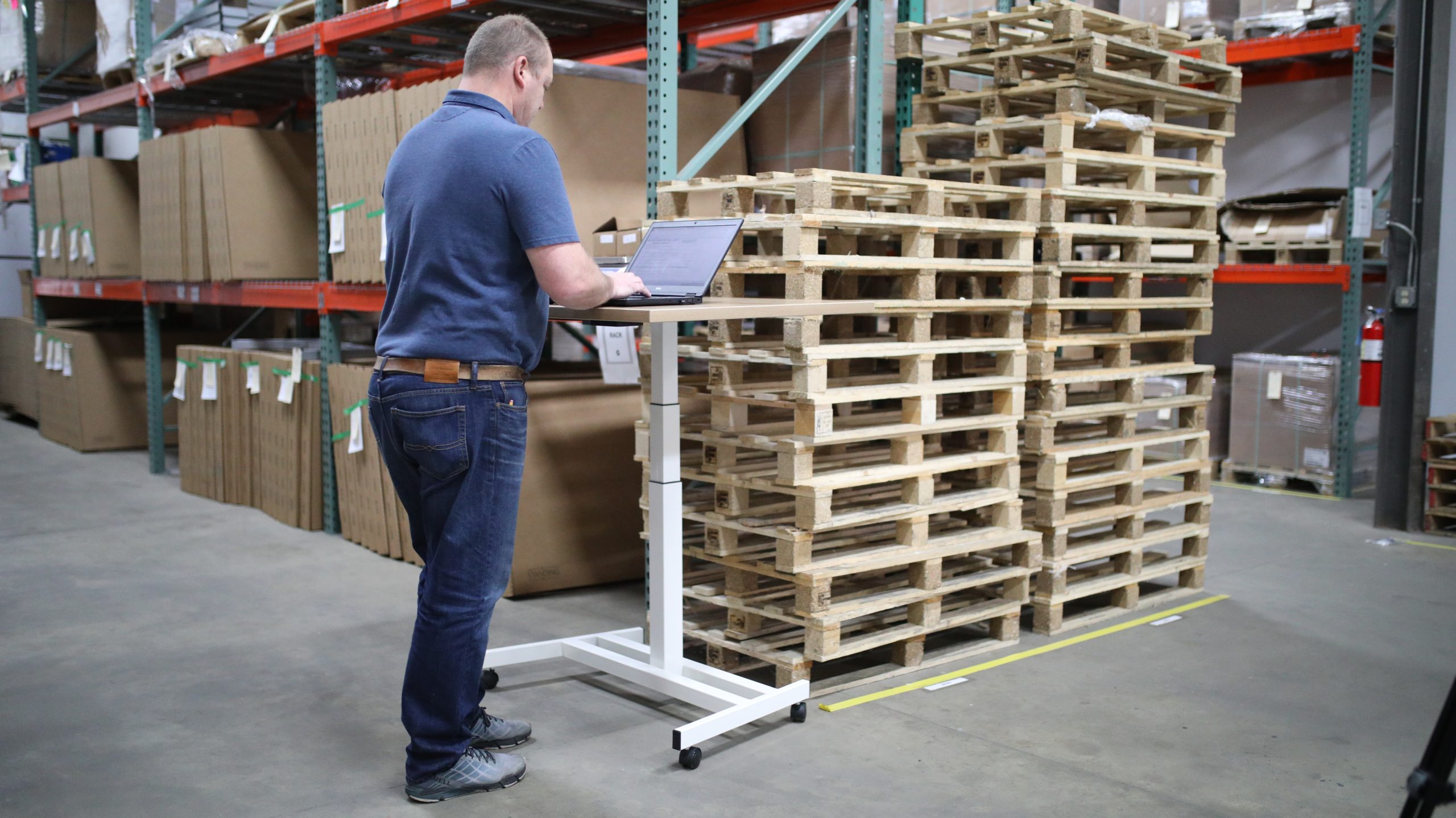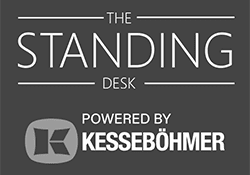Is standing up at work healthier than sitting down?
Office jobs have become increasingly sedentary in the past few decades, contributing to an overall epidemic of sitting. Do the benefits of standing at work make standing full time a healthier option? The truth is that standing all day is really no healthier than sitting all day. The key is to find the best of both worlds: a height adjustable sit stand desk.
What are health risks or issues associated with sitting all day or too much time spent sitting?
According to the Annals of Internal Medicine, the average person sits for half of their waking hours, and all of this time sitting can lead to serious health issues. Cardiovascular disease, diabetes, osteoporosis, back pain, obesity, and mood disorders are only some of the known health risks of desk jobs. Fortunately, the benefits of stand up desks at work can help counteract some of these negative health effects.
Does standing burn more calories?
Movement causes fat-burning enzymes to stay activated, and as a result, burns more calories than simply sitting still. One study showed that, on its own, standing burned about 8 more calories per hour than sitting – a very slow march to weight loss.
Does standing at a desk help you lose weight?
So, do you burn calories at a standing desk? For sure. Do standing desks help you lose weight? That’s a little less clear, although some research indicates slight weight loss. The way that standing can help weight loss is that it increases the likelihood of moving about (shifting weight, pacing, etc.), which further increases calorie expenditure.
So how does standing at work help you lose weight? Moving helps fat-burning enzymes to stay activated, which in turn burns more calories than remaining sedentary. Even the smallest exertions have an impact on our energy expenditure throughout the day. Over weeks and years, it all adds up. If you add other movement to your workstation, such as an under desk treadmill or a desk bike, even more calories are burned.
Do standing desks help with back pain?
More than 80% of adults report some sort of back pain at least once in their life. As any back pain sufferer knows, certain postures and activities can exacerbate the problem. For office workers, sitting at their desk is often the source of their pain. In fact, too much sitting can cause herniated discs, damaged nerves, and degenerated joints associated with back pain. The Take a Stand Project in 2011 found that reducing sitting time by using a sit-stand workstation decreased upper back and neck pain by 54%.
Doesn’t standing all day hurt your back too?
Studies show that prolonged standing is associated with a number of problems, including lower back pain, fatigue, and discomfort. In fact, standing all day can be just as damaging as sitting all day, causing tightness and discomfort in the legs and back.
Is it healthier to switch between standing and sitting?
Switching between sitting and standing guarantees shifts in posture that can reduce inactivity and allow people to naturally move to the most comfortable position. Indeed, our bodies work best when we can switch positions whenever joint pain or muscle fatigue prompts us to.
How does standing affect blood pressure or blood sugar?
There is a strong connection between sedentary behavior and negative effects on blood sugar and blood pressure. In fact, a 2016 study found that sitting time correlates strongly with diabetes and other chronic disease.
Standing affects both blood pressure and blood sugar. Within 90 seconds of standing up, cellular and muscular systems are initiated for using insulin and processing blood glucose, triglycerides, and cholesterol. Our arteries dilate, and muscles are engaged to push more fuel into our cells.
- Blood sugar: Standing at work, particularly after eating lunch, significantly reduces blood sugar. One reason is that sitting makes your body work harder to absorb sugar and produce insulin. The result is too much stress on cells that make insulin, which can be an important risk factor for diabetes. When researchers at the University of Leicester studied workers who sat continuously vs workers who stood every 30 minutes, they found that the workers who stood were able to lower their blood sugar 34%, as well as lowering their insulin levels.
- Blood pressure: Sitting a lot reduces blood flow, allowing fatty acids to build up in blood vessels, which eventually can lead to heart disease. Standing helps muscles burn more fat and increases blood flow, so fatty acids have a harder time clogging the heart.
The Recken Desk
Now Only $799
Experience the Strong, Safe & Intelligent Recken Standing Desk
Shop The ReckenDoes standing affect risks for heart disease, diabetes, or other diseases?
We know that extended sitting increases the harmful effects of blood sugar and fat metabolism, which directly affects an individual’s risk of heart disease and diabetes.
- Heart Disease: Standing is one way to help reduce the risk of heart disease. An enzyme called lipoprotein lipase breaks down fat in the blood and processes it for muscles to use during activity. According to a study of exercise physiology, inactivity suppresses lipoprotein lipase, which leaves fat in the blood and contributes to increased risk of heart disease. In fact, sitting reduces lipoprotein lipase production by about 90%. To make sure that your body can use fat as designed, rather than storing it – stand up!
- Diabetes: At the same time, standing can reduce the risk of diabetes. One study published in Diabetes Care found that breaking up prolonged sitting reduced glucose, insulin, and NEFA responses in women at risk of type 2 diabetes.
How does standing affect energy levels?
For an immediate energy boost – stand up! Try it and see for yourself. It may sound simple, but the act of standing increases alertness and provides a quick jolt of energy.
What is actually happening? Blood flow to the brain slows when you’re sitting, reducing the amount of oxygen your brain receives. Simply standing and moving slightly increases blood flow ever so slightly – and the result is noticeable.
Sit stand desks may help you cut down on coffee, caffeine, or other stimulants
If you’re looking to kick your caffeine habit, look no further than your standing desk. Periodic standing is a natural way to help reduce reliance on coffee and energy drinks. To prevent an afternoon energy crash, alternate sitting and standing.
Does standing at your desk affect your mood?
What do you do when you first meet someone? Stand and shake their hand. Think about it – if you want to project confidence in any situation, whether meeting a new person or speaking in public, you’ll likely be standing. The act of standing has a powerful effect on our mood and our confidence.
When we move our muscles, fresh oxygenated blood is pumped to our brains, releasing mood enhancing chemicals. It’s no wonder people report that their overall wellbeing is improved by using a standing desk. In fact, 62% of standing desk users in the Take a Stand study reported feeling happier than traditional desk users.
Do standing desks increase mental focus, or productivity?
When standing at work, people tend to spend less time on unproductive and time-wasting activities like social media. The result is an overall productivity boost for the entire day. In fact, a widely known study of call center workers found that their productivity increased 45% when they stood during calls.
Improved comfort and the ability to accommodate natural positions can help improve focus and productivity. If you’re interested in increasing your daily productivity with very little effort, it makes sense to try a height adjustable desk. Be sure to find a sit stand desk that adjusts quickly and smoothly along with your body’s natural movement to minimize distractions.
Are there other health benefits to using a standing desk or a sit/stand desk?
Many people report greater comfort, enhanced mood, and general improvements in wellbeing as benefits of sit stand desks. When we consider how our bodies evolved from hunter/gatherer cultures, standing desk health benefits make even more sense.
If you’re interested in the benefits of standing versus sitting at work, find a height adjustable desk that allows both. Try it for 30 days risk free. We’re confident you’ll find something to love. And the improvements in your physical, mental, and metabolic health may surprise you.





